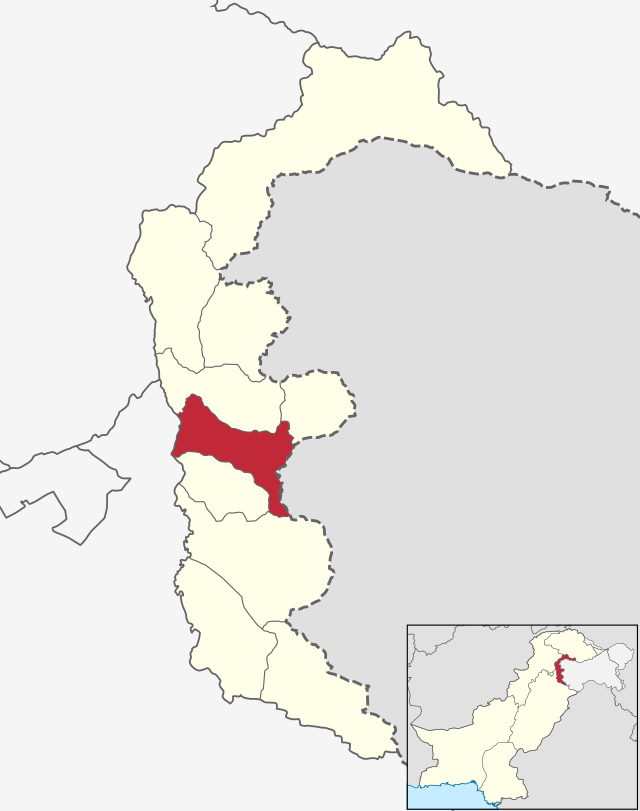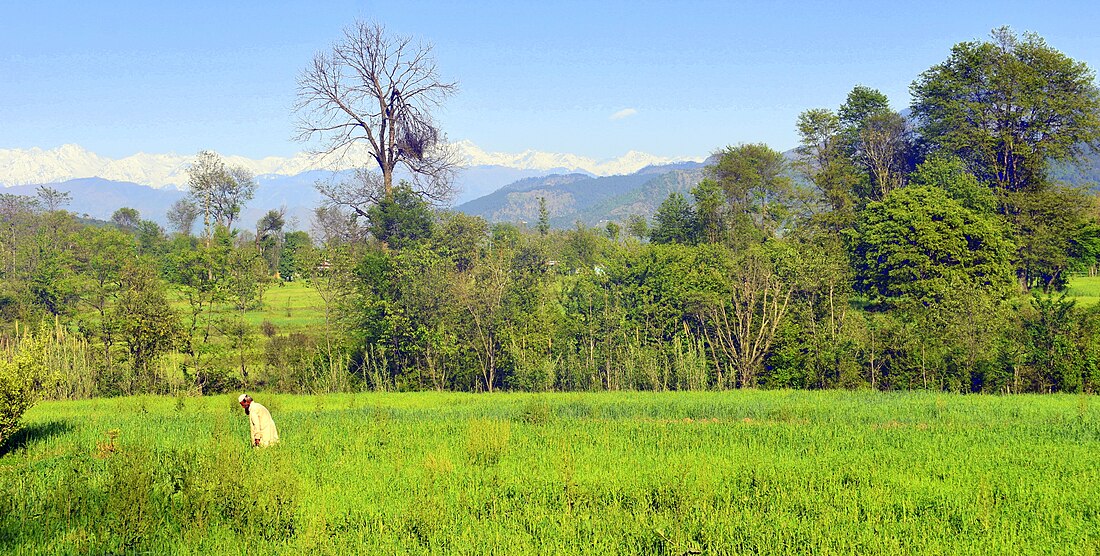Poonch District, Pakistan
District of Azad Kashmir administered by Pakistan From Wikipedia, the free encyclopedia
Poonch District (Urdu: ضلع پونچھ ) is a district of Pakistan-administered Azad Kashmir in the disputed Kashmir region.[1] It is one of the 10 districts of this Pakistan-administered territory. It is bounded on the north by Bagh District, on the north-east by Haveli District, on the south-east by the Poonch District of Indian-administered Kashmir, on the south by Azad Kashmir's Sudhanoti and Kotli districts, and on the west by Rawalpindi District of Pakistan's Punjab Province. The Poonch District is part of the greater Kashmir dispute between India and Pakistan. The district headquarters is the city of Rawalakot. It is the third most populous district of Azad Kashmir.[4][5]
Poonch District
ضلع پونچھ | |
|---|---|
District of Azad Kashmir administered by Pakistan[1] | |
  top: Poonch Valley bottom:Tolipir | |
 Interactive map of Poonch district | |
 A map showing Poonch district shaded in Yellow along with Sudhanoti district | |
| Coordinates (Rawalakot): 33°51′12″N 73°45′5″E | |
| Administering Country | Pakistan |
| Territory | Azad Kashmir |
| Division | Poonch Division |
| Headquarters | Rawalakot |
| Government | |
| • Type | District Administration |
| • Deputy Commissioner | N/A |
| • District Police Officer | N/A |
| • District Health Officer | N/A |
| Area | |
• Total | 855 km2 (330 sq mi) |
| Population (2017)[2] | |
• Total | 500,571 |
| Languages | |
| • Official | Urdu[3] |
| • Spoken | Pahari-Pothwari |
| Number of Tehsils | 4 |
The main language is Pahari, native to an estimated 95% of the population, but there are also speakers of Gujari,[6] while Urdu has official status.

History
Summarize
Perspective
Sovereign State
Around 850CE, Poonch became a sovereign state ruled by Raja Nar. According to Rajatrangani, Raja Trilochanpal of Poonch resisted Mahmood Ghaznavi who invaded Poonch 1020. Ghaznavi failed to enter Kashmir, as he could not capture the fort of Lohara (modern day Loran, in district of Poonch).[7]
Mughal Era (1596 - 1752)
In 1596, Mughal emperor Jahangir made Siraj-Ud-Din the ruler of Poonch. The Mughals were the rulers of Poonch until 1752.
Durrani Empire (1752–1819)
Under the leadership of Ahmad Shah Abdali, the Durrani Afghans conquered Kashmir, taking advantage of the declining Mughal Empire. They thus obtained control of Poonch, and established their government in the region. They ruled the region until 1819, when the Sikh Empire routed them from the Kashmir Valley, and annexed parts of Poonch (eastern half). They subsequently lost rule in any remaining territories in Kashmir.[8]
Tribal Coalitions (1819–1832)
In the western parts of Poonch (modern day Poonch Division, AJK) the local tribes had entrenched themselves in the hills. The Muslim tribes of the region formed a defensive coalition against the Sikhs, at the head of which was the Sudhan tribe.[9]
After Gulab Singh received the chakla of Jammu as a jagir (autonomous territory), he made renewed attempts at conquering Poonch, but the armies he raised were not large enough to defeat the resistance, and consequently he would face defeats before being forced to withdraw.[10]
In 1832, Gulab Singh convinced Ranjit Singh to attack the coalition. Ranjit marched with an army of 60,000 troops alongside an assortment of hill cannons. The coalition made the decision to surrender, accepting the suzerainty of the Sikhs over Poonch.[11]
Sikh Empire (1819–1846)
The Sikhs had conquered the eastern part of Poonch in 1819, but did not exert full control over it until the tribal coalition was defeated in 1832.[9]
In 1822, Ranjit Singh appointed Gulab Singh as the Raja of Jammu and, in 1827, appointed Dhyan Singh as the Raja of Bhimber, Chibbal and Poonch[12] (covering the Mirpur and Poonch districts as of 1947[13]). Dhyan Singh spent most of his time in Lahore, subsequently becoming the diwan (prime minister) in the Sikh court. Gulab Singh is said to have managed his jagirs on his behalf.
In 1837, the hill tribes of Poonch, led by the Sudhans[14] launched a rebellion. They captured Sikh garrisons and defeated the son of Gulab Singh, Ottam Singh, whom had been sent with a force of five thousand troops to crush the rebellion. Though the rebels captured the majority of Poonch, after Gulab Singh returned from his campaign against the Yusufzai, he was able to incite treachery within the rebellion. Gulab Singh then attacked with an army of twenty-thousand which he had raised in Kahuta, and after fierce fighting and aid of Sikh reinforcements, he captured key forts of the rebels and their leaders, flaying alive Sudhan sardars Malli Khan and Sabz Ali Khan, executions of other commanders and notables from the rebellious tribes and killed the main leader of the rebellion, Shams Khan. Gulab Singh's forces caused devastation and massacres within captured rebel territory, due to which he faced controversy, particularly by the British, and obtained the reputation of a tyrant.[12][15][16][17]
After the death of Ranjit Singh in 1839, the Sikh court fell into anarchy and palace intrigues took over. Dhyan Singh, Suchet Singh as well as Dhyan Singh's son Hira Singh were murdered in these struggles.[18] Poonch was confiscated by the Sikh Durbar on the grounds that the Rajas had rebelled against the state and handed it over to Faiz Talib Khan of Rajouri.[19]
Princely state of Jammu and Kashmir (1846–1947)
After the First Anglo-Sikh War (1845–1846) and the subsequent Treaties of Lahore and Amritsar, the entire territory between the Beas and the Indus rivers was transferred to Gulab Singh, including Poonch. He was recognised an independent ruler, a maharaja, of the newly created state of Jammu and Kashmir.[20] Gulab Singh reinstated the jagir of Poonch to Jawahir Singh, the eldest remaining son of Dhyan Singh. Thus, the Dogra dynasty became the rulers of the state.[19]
In the 1947 Poonch Revolt, the rebels expelled Dogras from Poonch (modern day Poonch Division, AJK), and established Azad Kashmir.[21][22][23][24]
Separation of Poonch

(The Poonch Divion was created from the Azad Kashmiri-administered portion of the pre-1947 Poonch District.)
After independence in 1947, there was a rebellion in the western part of the Poonch District. The rebels led by Sardar Ibrahim Khan, sought support from the Dominion of Pakistan, which provided arms and then launched an invasion of its own, using Pashtun tribals. In response, the Maharaja of Jammu and Kashmir joined India, and the conflict turned into an Indo-Pakistani war. When a ceasefire was effected, the Poonch District was divided into two separate districts. The former headquarters, the city of Poonch, came under Indian occupation, and a new headquarters in the western district was eventually established at Rawalakot.
1949 to Present
The Pakistan-administered portion of the Poonch district was reorganised as the Poonch Division. Of the four tehsils of the original Poonch District, viz., Bagh, Sudhnoti, Haveli, and Mendhar, the Poonch Division included the first two and a portion of the third. Those three tehsils were eventually made separate districts, and a new Poonch District was created in the center of the Poonch Division by incorporating portions of the Bagh and Sudhnoti tehsils.
Poonch district was the main area of violent anti government revolt (led by the Sudhan tribe) during the 1955 Poonch uprising, which lasted from early 1955 to late 1956.[25]
Administrative divisions
The district is administratively subdivided into four tehsils:[26]

Towns
Dhamni
Ali Sojal
Jandali
Shaheed Gala
Dothan
Education
According to the Pakistan District Education Ranking 2017, a report released by Alif Ailaan, the Poonch District is ranked at number 8 nationally, with an education score of 73.52. Over the past five years, the Poonch District has shown the most improvement in the establishment of middle schools. The learning score for the Poonch District is 84.15.[27] The school infrastructure score for the Poonch District is 14.88, ranking the district at number 151, which places it in the bottom five districts relating to infrastructure in Pakistan and its two dependent territories. Schools in the Poonch District also have severe problems with regard to electricity, drinking water, and boundary walls, as reflected in their scores of 2.67, 12.1, and 6.23, respectively.[27] The state of some school buildings also presents a major safety risk for students.
Transport
The Poonch-Rawalakot Bus, which crosses the LOC, has helped to re-establish ties across the border.[28]
See also
- History of Poonch District
- Poonch district, India
- 1947 Poonch Rebellion
- Poonch Medical College in Rawalakot
- Shaheed Gala
- Hussainkot
References
Bibliography
External links
Wikiwand - on
Seamless Wikipedia browsing. On steroids.
